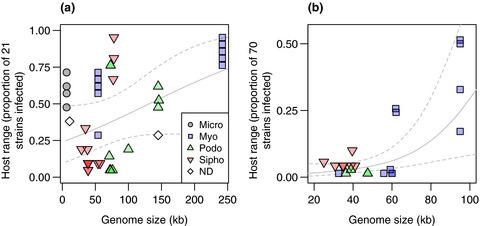当前位置:
X-MOL 学术
›
Ecol. Lett.
›
论文详情
Our official English website, www.x-mol.net, welcomes your
feedback! (Note: you will need to create a separate account there.)
Making sense of virus size and the tradeoffs shaping viral fitness
Ecology Letters ( IF 7.6 ) Pub Date : 2020-11-04 , DOI: 10.1111/ele.13630 Kyle F. Edwards 1 , Grieg F. Steward 1 , Christopher R. Schvarcz 1
Ecology Letters ( IF 7.6 ) Pub Date : 2020-11-04 , DOI: 10.1111/ele.13630 Kyle F. Edwards 1 , Grieg F. Steward 1 , Christopher R. Schvarcz 1
Affiliation

|
Viruses span an impressive size range, with genome length varying a thousandfold and virion volume nearly a millionfold. For cellular organisms the scaling of traits with size is a pervasive influence on ecological processes, but whether size plays a central role in viral ecology is unknown. Here, we focus on viruses of aquatic unicellular organisms, which exhibit the greatest known range of virus size. We outline hypotheses within a quantitative framework, and analyse data where available, to consider how size affects the primary components of viral fitness. We argue that larger viruses have fewer offspring per infection and slower contact rates with host cells, but a larger genome tends to increase infection efficiency, broaden host range, and potentially increase attachment success and decrease decay rate. These countervailing selective pressures may explain why a breadth of sizes exist and even coexist when infecting the same host populations. Oligotrophic ecosystems may be enriched in “giant” viruses, because environments with resource‐limited phagotrophs at low concentrations may select for broader host range, better control of host metabolism, lower decay rate and a physical size that mimics bacterial prey. Finally, we describe where further research is needed to understand the ecology and evolution of viral size diversity.
中文翻译:

了解病毒大小和影响病毒适应性的权衡
病毒的大小范围令人印象深刻,基因组长度变化千倍,病毒体体积变化近百万倍。对于细胞生物而言,大小随性状的缩放对生态过程具有普遍影响,但大小是否在病毒生态学中起核心作用尚不清楚。在这里,我们专注于水生单细胞生物的病毒,它们表现出最大的病毒大小范围。我们在定量框架内概述假设,并在可用的情况下分析数据,以考虑大小如何影响病毒适应性的主要组成部分。我们认为,较大的病毒每次感染的后代较少,与宿主细胞的接触速度较慢,但是较大的基因组往往会提高感染效率,扩大宿主范围,并可能增加附着成功率并降低衰变率。这些抵消性的选择压力可以解释为什么在感染相同的宿主种群时存在如此宽的大小甚至共存的原因。寡营养型生态系统可能富含“巨型”病毒,因为在低浓度条件下具有资源有限的噬菌体的环境可能会选择更大的宿主范围,更好地控制宿主代谢,降低腐烂率以及模仿细菌猎物的物理尺寸。最后,我们描述了需要进一步研究以了解病毒大小多样性的生态和进化的地方。较低的衰减率和模仿细菌猎物的物理尺寸。最后,我们描述了需要进一步研究以了解病毒大小多样性的生态和进化的地方。较低的衰减率和模仿细菌猎物的物理尺寸。最后,我们描述了需要进一步研究以了解病毒大小多样性的生态和进化的地方。
更新日期:2021-01-11
中文翻译:

了解病毒大小和影响病毒适应性的权衡
病毒的大小范围令人印象深刻,基因组长度变化千倍,病毒体体积变化近百万倍。对于细胞生物而言,大小随性状的缩放对生态过程具有普遍影响,但大小是否在病毒生态学中起核心作用尚不清楚。在这里,我们专注于水生单细胞生物的病毒,它们表现出最大的病毒大小范围。我们在定量框架内概述假设,并在可用的情况下分析数据,以考虑大小如何影响病毒适应性的主要组成部分。我们认为,较大的病毒每次感染的后代较少,与宿主细胞的接触速度较慢,但是较大的基因组往往会提高感染效率,扩大宿主范围,并可能增加附着成功率并降低衰变率。这些抵消性的选择压力可以解释为什么在感染相同的宿主种群时存在如此宽的大小甚至共存的原因。寡营养型生态系统可能富含“巨型”病毒,因为在低浓度条件下具有资源有限的噬菌体的环境可能会选择更大的宿主范围,更好地控制宿主代谢,降低腐烂率以及模仿细菌猎物的物理尺寸。最后,我们描述了需要进一步研究以了解病毒大小多样性的生态和进化的地方。较低的衰减率和模仿细菌猎物的物理尺寸。最后,我们描述了需要进一步研究以了解病毒大小多样性的生态和进化的地方。较低的衰减率和模仿细菌猎物的物理尺寸。最后,我们描述了需要进一步研究以了解病毒大小多样性的生态和进化的地方。











































 京公网安备 11010802027423号
京公网安备 11010802027423号